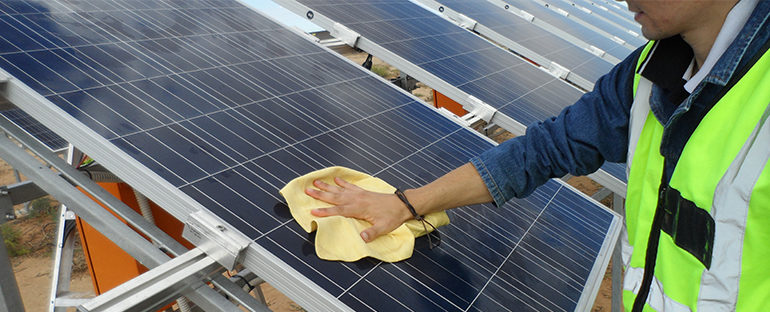As a result of exceedingly rapid growth in the solar energy market, at least 114,9 GW of photovoltaic (PV) systems have been installed and commissioned globally in 2019. As a result, the potential of PV as a financial investment has risen accordingly. Furthermore, the operations and maintenance of PV plants are largely influencing the risk and return of such investments. Research related to field performance and degradation of PV modules has therefore received markedly increased focus over the last couple of years.
Soiling is one of the more efficient site-specific mechanisms of performance losses in PV plants. As a result, global studies on soiling losses in PV installations is a highly active research field. The power output of PV modules depends largely on the module’s conversion efficiency and the irradiation in the module plane. The level of soiling on a PV module surface varies with the location of a PV system, as well as with its layout characteristics such as its tilt angle, the height of installation, mounting type, module surface and module frame. Furthermore, both climatic conditions and the local environmental impact the extent and the seasonality of the soiling growth.
- Research aims
The research studies soiling losses at a PV plant in a region with a semi-arid climate in South Africa. South Africa has a high potential to generate PV energy as a result of high solar irradiation and vast areas of unused land. The South African Renewable Energy Independent Power Producer Procurement Program (REIPPPP) was introduced in 2010 and aimed to instal 3.7 GW of renewable energy. In the first five years, the programme yielded private investments of $12 billion in renewable energy, with approximately 50% of the investments being in PV plants. However, the effect of soiling upon the performance of the resulting PV plants is not well documented in the available literature. A study of soiling effects in South Africa could therefore reduce the risks of future investments in PV plants and contribute to smarter planning of cleaning schedules, which will reduce operations and maintenance costs of existing and future installations. The study used direct measurement techniques of soiling levels in the field and current-voltage (IV) data to determine the soiling losses at the site in South Africa. The direct quantification of soiling levels was based on the weight of the dust on the PV modules and the corresponding change in transmittance of light through the module glass. The measurements were conducted on field exposed PV modules to present realistic soiling conditions.
Experimental set up
The data analysed in this research, is measured at an outdoor test site located within Scatec Solar’s 75 MWp PV plant in Kalkbult in the Northern Cape. The area is semi-arid, with annual precipitation of approximately 300-400 mm, with most of the rainfall occurring during summer and autumn. The region is flat with low hills, and the soils are primarily characterised by a rocky subsurface and a sandy upper surface. Calcium carbonate beds are common, especially in the Kalkbult area. The vegetation in this area varies from a graminoid habitat to a forb- or shrub-based habitat, and the only agricultural activity is livestock farming. On one side of the test facility, there are railroad tracks and a gravel road, both with little traffic.
Methodology
To estimate the effect of soiling, the power output of clean and soiled modules was compared, an approach that is similar to previous research studies. Half of the modules of each type were left uncleaned, to be used as reference samples. For the other half, surface cleaning (dry cleaning and distilled water cleaning) was applied at intervals of approximately 2 weeks for the entire experiment duration of 14 months, using a microfiber cloth. As the performance of the regularly cleaned modules did not increase significantly after cleaning, this frequency was assumed sufficient. To ensure a reliable comparison of the clean and soiled modules, data was analysed for midday hours only, on days with clear sky conditions. This minimises the difference in the angle of incidence of the irradiance on the modules and also reduces the variability in modules’ efficiency due to changing light conditions.
Conclusions
The research presented a comprehensive analysis of dust deposition and related soiling losses for a site in South Africa. The soiling losses at the site were low, which was confirmed by performance analysis on module level, optical measurements and gravimetry. In July, when the soiling losses were found to be at maximum, the average power output loss due to soiling was a mere 1-2%. A daily dust accumulation of 0.02-0.04 g/m2 was measured in October. The effect of natural cleaning proved to be sufficient, and dry cleaning and cleaning with distilled water had an equal effect. The treatment with the anti-soiling product appeared to not reduce soiling losses, contrary to its purpose. The comparison of cleaning with and without water, the effect of natural cleaning, and the effect of the anti-soiling treatment should be related to site-specific effects which could be described through the size distribution and the chemical composition of the dust. Analysis of the airborne dust particles at the site showed that the median diameter of the particles likely to settle on PV modules were 10 µm, and that carbon, sodium and silicon were the dominating elements.
Acknowledgements:
The funding and technical support through the SANCOOP (South Africa – Norway Research Co-operation on Climate Change, the Environment and Clean Energy) project titled “Performance of PV modules in arid areas – effect of soiling and module technology on yearly yield”, a collaborative led jointly by the Institute for Energy Technology (IFE) in Norway and Stellenbosch University in South Africa, and closely linked to Scatec Solar, is acknowledged.





